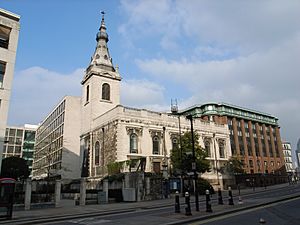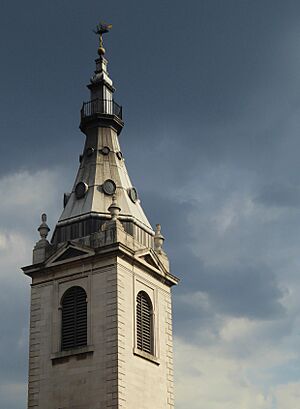St Nicholas Cole Abbey facts for kids
Quick facts for kids St Nicholas Cole Abbey |
|
|---|---|
 |
|
| Location | London, EC4 |
| Country | United Kingdom |
| Denomination | Church of England |
| Previous denomination | Roman Catholic |
| Churchmanship | Conservative evangelical |
| Architecture | |
| Architect(s) | Sir Christopher Wren |
| Style | Baroque |
| Administration | |
| Diocese | London |
St Nicholas Cole Abbey is a historic church in the City of London. It stands on what is now Queen Victoria Street. This church has been around since the 1100s! It was sadly destroyed in the Great Fire of London in 1666. After the fire, it was rebuilt by the famous architect Sir Christopher Wren's team.
Later, during the Second World War, the church was badly damaged by bombs in the London Blitz. It was then rebuilt again by Arthur Bailey between 1961 and 1962.
| Top - 0-9 A B C D E F G H I J K L M N O P Q R S T U V W X Y Z |
The Church's Story: A Look Back
What's in a Name?
The church is named after Saint Nicholas of Myra, who lived in the 300s. He is known as the patron saint of children and fishermen, among others. The "Cole Abbey" part of the name comes from an old word, "coldharbour." This word meant a shelter for travelers or a place to get out of the cold. Even though it has "Abbey" in its name, it was never actually an abbey (a monastery led by an abbot).
The first time this church was mentioned was in a letter from Pope Lucius II in 1144 or 1145.
Ties to Children and Fish
Because Saint Nicholas is the patron saint of children and fishermen, the church has some special connections to both.
- Children: An old list of the church's items from the time of the Protestant Reformation shows clothes for children. This suggests the church might have had a tradition of choosing a "boy bishop" on Saint Nicholas Day.
- Fish: In the late 1100s, during the time of King Richard I, there was a new fish market near St Nicholas Cole Abbey. In 1272, the church was even called "St Nick's behind Fish Street." Many fish sellers were buried here in the 1500s. A writer named John Stow noted that in the time of Queen Elizabeth I, a water tank fed by the River Thames was built near the church for the local fishmongers.
Changes During the Reformation
Like all churches in England, St Nicholas Cole Abbey became Protestant during the Reformation. When Queen Mary I became queen, it was the first church to hold a Mass (a Catholic church service) again on August 23, 1553. The priest at the time, Thomas Sowdley, had been allowed to marry when King Edward VI was in charge. Because Queen Mary I was Catholic, he lost his job for being married.
However, when Queen Elizabeth I became queen, Sowdley got his job back.
The Great Fire and Rebuilding
The church was completely destroyed in the Great Fire of London in 1666. King Charles II had planned to give the land to a different church group, but this did not happen. Instead, the church's area was combined with that of St Nicholas Olave, another nearby church that was also destroyed but not rebuilt.
St Nicholas Cole Abbey was rebuilt between 1672 and 1678. It cost about £5042, which was a lot of money back then! Records show that money was spent on "Dinner for Dr Wren and other Company" and even "Half a pint of canary for Dr Wren's coachmen." It was the very first of the 51 churches lost in the Great Fire to be rebuilt.
Victorian Changes and a New Leader
In the Victorian era, London's streets were changed a lot. A new road, Queen Victoria Street, was built. This meant the south side of the church, which used to be hidden by buildings, now faced the new street. So, in 1874, the church was changed inside. New windows were added on the south side, and the main entrance moved from the northwest to the south.
By the late 1800s, smoke from underground trains made the church's outside so dark that people sometimes called it "St Nicholas Cole Hole Abbey."
In 1883, Henry Shuttleworth became the new rector (the main priest). He was a Christian Socialist, meaning he believed in Christian values combined with social justice. He made the church a lively place, adding a bar, starting many music programs, and making it a center for discussions. This worked! By 1891, St Nicholas Cole Abbey had the largest church attendance of any church in the City of London, with up to 450 people on a Sunday evening.
World War II Damage and Restoration
On May 10, 1941, London had its worst air raid during the entire Second World War. Many buildings were destroyed or badly damaged, including St Nicholas Cole Abbey. The church was left as an empty shell until it was restored by Arthur Bailey. It was opened again in 1962.
Recent History and Present Day
After its restoration, St Nicholas Cole Abbey became the headquarters for the Diocesan Council for Mission and Unity. For a while, from 1982 to 2003, it was used by the Free Church of Scotland.
In 2014, the building reopened as the St Nicholas Cole Abbey Centre for Workplace Ministry. It also has a cafe called The Wren.
Since November 2016, Sunday services have restarted at the church, now known as St Nick's Church. They also have midweek meetings. The church follows a conservative evangelical style of the Church of England.
Church Design and Features
The church is a Grade I listed building, which means it's a very important historic building.
Outside the Church
The church is made of stone with special corner blocks called quoins. Some parts of the south and west walls are even older, from medieval times. On top of the church building, there's a decorative railing called a balustrade. The windows have arches with square frames, a design often used by Wren.
On the northwest corner, there's a square tower. On top of the tower is a lead spire shaped like an upside-down trumpet. Each corner of the tower has a small flaming urn decoration. The spire has two rows of small, curved windows and a tiny balcony near the top, which looks a bit like a crow's nest on a ship. At the very top, there's a weather vane shaped like a three-masted sailing ship. This ship weather vane came from another church, St Michael Queenhithe, and was added in 1962. The tower is 135 feet tall and holds one bell.
Inside the Church
The east wall inside the church has three beautiful stained glass windows. They were designed by Keith New, who also worked on the windows for Coventry Cathedral. These windows replaced older ones that were destroyed in 1941.
- The window on the left shows St Nicholas Cole Abbey as the center of the world, with crosses pointing in all directions.
- The middle window shows the Rock of Christ with an ark (like Noah's Ark, representing the church) on four rivers (representing the Gospels).
- The window on the right shows seven lamps, symbolizing the church spreading around the world.
The inside of the church is mostly simple, with tall, decorative columns called Corinthian pilasters. In a small room to the northwest, there's a floor made of "crazy paving" from broken old gravestones.
Some parts of the church from the 1600s still exist today. These include the carved pulpit (where the priest gives sermons), the cover for the font (where baptisms happen), part of the communion rail, and parts of the original reredos (a screen behind the altar), which are now on the south wall. The church also has a coat of arms from the time of King Charles II.
Behind a panel near the south door, there's a medieval stone head that was found during the church's restoration. The organ in the church was built by Noel Mander for the restored building.
Services and Activities
St Nick's Church holds services every Sunday at 11:00 AM. These services are modern in style. There are also Sunday clubs and a crèche (a nursery) for younger children and youth. Before the service, coffee and pastries are served from 10:30 AM, and there's a casual lunch afterward.
Small groups meet on Wednesday evenings. They start with a meal at 6:15 PM, followed by a Bible study and prayer at 7:00 PM. St Nick's Talks happen every Thursday lunchtime at 1:05 PM. These talks aim to share the good news of Jesus Christ from the Bible with people who work nearby.
St Nicholas Cole Abbey in Pop Culture
- The church and its history have inspired creative works. For example, Henry Shuttleworth, a former rector, was the model for a character named James Morrell in George Bernard Shaw's 1898 play Candida.
- The damaged shell of St Nicholas Cole Abbey was used as a filming location for a gold heist scene in the 1951 Ealing comedy movie The Lavender Hill Mob.
- The church is mentioned in Iris Murdoch's first novel, Under the Net, published in 1954.
- St Nicholas Cole Abbey was also used as a location in a 1968 episode of the TV show Doctor Who called The Invasion.
See also




